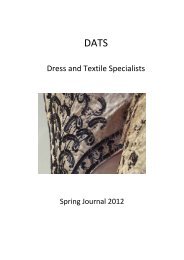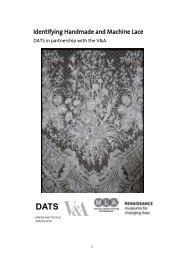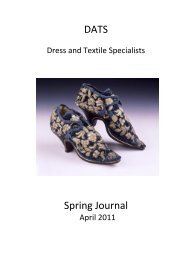Identifying Textile Types and Weaves 1750-1950 - Dress and Textile ...
Identifying Textile Types and Weaves 1750-1950 - Dress and Textile ...
Identifying Textile Types and Weaves 1750-1950 - Dress and Textile ...
You also want an ePaper? Increase the reach of your titles
YUMPU automatically turns print PDFs into web optimized ePapers that Google loves.
<strong>Identifying</strong> <strong>Textile</strong> <strong>Types</strong> <strong>and</strong> <strong>Weaves</strong><br />
Glossary of Terms<br />
This selective glossary is intended to serve as an aid to those individuals wishing to identify cloth types,<br />
within museum or archival Collections. The terms are explained in a simple <strong>and</strong> easy to use manner with<br />
view to ease of identification rather than technical details on how to weave each respective cloth. We have<br />
also tried to explain the history behind some techniques <strong>and</strong> highlighted that usage of some terms has<br />
changed over time. The source of each definition is noted in parenthesis after the text <strong>and</strong> a dated key to<br />
these sources is listed at the bottom. More comprehensive glossaries can be found in several of the texts<br />
listed in the Bibliography.<br />
Basket<br />
Beam (warp)<br />
Bouclé<br />
Bourette<br />
Brilliantine<br />
Broadcloth<br />
Chambray<br />
Check<br />
Chenille<br />
A simple weave, usually in cotton or linen, which employs an over-under combination of equal<br />
number warps <strong>and</strong> wefts (usually two, three or four) to create a coarse surfaced cloth which<br />
resembles basket-work. [MERC]<br />
A beam in any of the horizontal rollers on which the warp yarn or finished cloth is wound <strong>and</strong><br />
secured. The main beam is fitted onto the back of the loom, <strong>and</strong> the cloth beam is fitted directly<br />
under where the weaver is sitting.[SK &MERC]<br />
An imitation astrakhan or cloth having knots, loops or curls on the surface. The name is French for<br />
buckled. The term is rather loosely applied to all fabrics having curls, knots or loops on the surface.<br />
[MERC]<br />
A silk dress material in which the surface is produced by using lumpy knotted yarns for both the<br />
warp <strong>and</strong> the weft. Cheap <strong>and</strong> durable, it was often made using silk waste <strong>and</strong> was much used for<br />
men‟s <strong>and</strong> women‟s clothing. [MERC]<br />
A light dress cloth with a cotton warp <strong>and</strong> wool (often mohair) weft, woven in both plain <strong>and</strong><br />
patterned designs. Its manufacturing process involved calendering after weaving to achieve a soft<br />
flat silky finish. Calendering is a process by which cloth is rolled between heated rollers to flatten<br />
the threads <strong>and</strong> add sheen. [MERC]<br />
A term that in many districts was used to indicate garments worn by the clergy. It is a stout wool<br />
cloth. Made from fine merino yarns, <strong>and</strong> heavily milled <strong>and</strong> finished with a dress face. It has a<br />
velvety feel <strong>and</strong> a silky gloss. Quality varies according to price. It is a superfine, smooth-faced <strong>and</strong><br />
dense fabric, <strong>and</strong> considered the perfection in woolen materials. [MERC]<br />
A light-weight, plain weave cotton or linen dress fabric, sometimes with gingham-style checks or<br />
stripes but retaining white selvedges. Used for overalls, aprons <strong>and</strong> children‟s dresses.[MERC}<br />
Any cloth with a pattern of rectangles or squares created by crossing striped warps with blocks of<br />
coloured wefts at right angles. [MERC]<br />
Fancy tufted yarn, used from the 17 th century <strong>and</strong> usually of cotton or silk, made by a weaving<br />
process. The threads are woven into a sold piece of cloth which is then cut along its length every<br />
28





